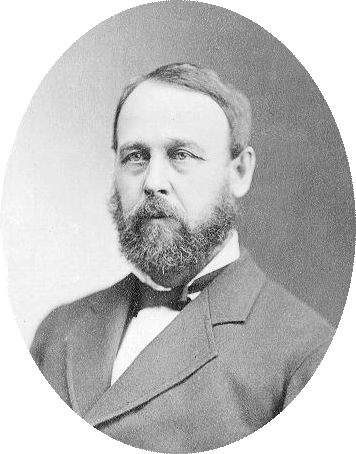
It is 1872, and Asaph Hall III will soon be forty-three. He grew up on a small farm in the Berkshires, fell into poverty at thirteen when his father died, become a carpenter, taught himself simple mathematics to help with his trade, dreamt of becoming an architect. Then he had seen an item in the New York Tribune that changed his life: New York Central College at McGrawville in the Finger Lakes region was advertising what would now be called a work-study programme, a classical education for labourers.
Angelo Hall, biographer of his parents, would someday write: "Massachusetts educators [i.e., presumably, Horace Mann] would have us believe that a young man of twenty-five should have spent nine years in primary and grammar schools, four years more in a high school, four years more at college, and three years more in some professional school. Supposing the victim to have begun his career in a kindergarten at the age of three ... at twenty-five his education would be completed. He would have finished his education, provided his education had not finished him. Now at the age of twenty-four or twenty-five Asaph Hall 3rd only began serious study ..."
In some ways Central College was much like any other. Two years earlier, a student named William Austin had written a letter to his family describing life at a place which "begins to seem like home ... a beautiful section of country somewhat uneven but just enough to waken mankind to the romantic beauties of nature." It might have been written by a student of almost any school or era, but one line reveals it to be an anomaly for 1852: "The Ladies all room at the hall."
Central College was co-educational; it was also biracial, a foundation established by radical Baptist fundamentalists on the cutting edge of every movement for social change. (Here, perhaps, the modern reader may feel that the past is indeed a foreign country.) Astonishingly, even the faculty at Central College originally included Blacks, among them the mathematician Charles L. Reason. Western New York in the first half of the 1800s was impoverished, rural, and deeply divided, the "Burnt-Over Country" of religious sectarians, utopian revolutionaries, and tough, conservative farmers. In 1852 the hostility of the local community and the limits of tolerance even within the hearts of some liberal reformers had brought Central College to a crisis when one of the Black professors, William G. Allen, became engaged to a white student. A mob attacked Allen, who narrowly escaped lynching; the couple fled to England with help from Louisa May Alcott's uncle (the incident would later become the basis of one his niece's sensational short-stories, "M.L."); and the already-struggling college, derided in the Syracuse newspaper as a "nigger institution", began a precipitous decline which would lead to its closure in 1860.
This was the precarious institution of higher learning in which Asaph Hall had enrolled, and where he quickly established himself as top student in mathematics. Among his teachers was a student assistant, a suffragist in bloomers named Angeline Stickney who became his wife. A typical Baptist feminist zealot, she felt no shame at having attended what she dryly termed "an unpopular institution". She wrote back to the college after her departure:
"I expect to get the name that I have heard applied to all who come here, 'fanatic'... Let me live, let me die a fanatic. I will not seal up in my heart the fountain of love that gushes forth for all the human race ... [T]here are none here to say, 'thus far thou mayst ascend the hill of Science and no farther.' ... I can see my brother gathering those golden fruits [of knowledge], and ... there are none here to whisper, 'that is beyond thy sphere, thou couldst never scale those dizzy heights'; but, on the contrary, here are kind voices cheering me onwards." Nevertheless, as so often happened even in the most idealistic Nineteenth-Century circles, she soon abandoned her own promising scientific career to become, almost literally, her husband's muse.
The Halls had wandered the Midwest, peripatetic school-teachers on the edge of beggary. They returned to the East; Asaph was hired as an assistant at the Harvard Observatory for a wage too low to live on, and began calculating for almanacs on the side. During the Civil War his fortunes improved; he obtained a senior post at the Naval Observatory and once gave a distinguished visitor a tour of the heavens. A journalist would later write [ Popular Science 45, 833 (1894)]:
"A few nights later the trap- door opened again, and the same figure appeared. He told Prof. Hall that after leaving the observatory he had looked at the moon, and it was wrong side up as he had seen it through the telescope. He was puzzled, and wanted to know the cause, so he had walked up from the White House alone. Prof. Hall explained to him how the lens of a telescope gives an inverted image, and President Lincoln went away satisfied." Whether the story is true or one of the countless Lincoln legends, who can say?
